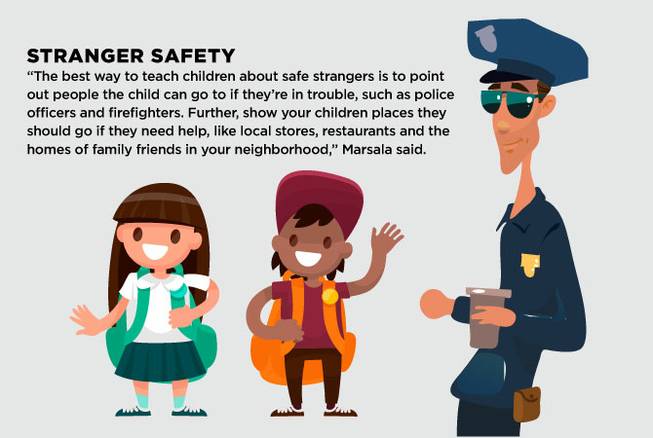
Monday, Aug. 14, 2017 | 2 a.m.
Most of us have heard the term “stranger danger.” It’s a slogan that’s been popular for decades, likely taught during childhood. However, while it’s important for children to understand the risks some strangers might pose, most strangers are not threatening and shouldn’t be feared.
“Stranger danger is the idea that all strangers can potentially be dangerous, but the National Center for Missing and Exploited Children is now encouraging parents to steer away from the phrase,” said Jeanne Marsala, RN, Safe Kids Clark County Director at Sunrise Children’s Hospital. “The reason is that most strangers are entirely safe and, conversely, the vast majority of adults who abuse children are not strangers.”
Rather than teaching “stranger danger,” parents should educate children about safe strangers while emphasizing caution, situational awareness and establishing boundaries.
Distinguishing between safe strangers and dangerous strangers
Children will encounter strangers regularly throughout their lives — the cashier at the supermarket, the new teacher at school, and the security guard at the shopping mall are all strangers. Children should learn to be cautious when meeting or dealing with anyone they don’t know, and understand that they cannot tell if strangers have good intentions just by looking at them. However, many strangers can help children who are in danger.
“The best way to teach children about safe strangers is to point out people the child can go to if they’re in trouble, such as police officers and firefighters. Further, show your children places they should go if they need help, like local stores, restaurants and the homes of family friends in your neighborhood,” Marsala said.
Tips for teaching children about strangers
• Role-play safe and unsafe interactions: Explain what warning signs to look out for, such as “strangers who tell children to keep secrets from their parents, disrespect personal boundaries or try to entice them to go anywhere without their parent’s permission,” Marsala said.
Knowing these warning signs can help children develop their instincts about dangerous people.
• Teach children to trust their instincts: Sometimes, we just get bad feelings about things — whether or not we can pinpoint why. These instincts are important, and children should learn to trust them.
Tell your child to get away from any person or situation that makes them feel scared, uncomfortable and/or uneasy.
• Give them tools for handling scary situations: Not only should children be able to identify certain unsafe indicators, they should know how to handle dangerous situations.
“One way is to teach them ‘No, Go, Yell, Tell,’: say no, run away, yell as loudly as he or she can (even indoors) and tell a trusted adult what happened immediately,” Marsala said. Make sure you know where your children are at all times, and that he or she has your work and cellphone numbers.
• Explain how they should draw boundaries with adults: Assure children that they can and should say “no” to any adult who makes them feel unsafe.
Emphasize that this is true for any adult, even those who are in an authoritative position.
• Encourage your children to play with other children their age: “There’s safety in numbers,” Marsala said.
Red flags to watch for in other adults
1. Routinely violating children’s personal space/boundaries.
Examples: refusing to let the child set his or her own limits, missing or ignoring cues about boundaries (both verbal and nonverbal) and/or ignoring a child’s need for and right to privacy.
2. Being overly focused on their relationships with children.
Examples: spending significant time with children and showing little interest in spending time with other adults, treating children more like peers by sharing personal or private information, or allowing children to get away with inappropriate behavior, having a “special” child friend and/or seeming overly eager to spend time with children (including frequent baby-sitting for free, taking children on outings alone, buying children gifts or giving them money for no reason).
3. Behaving in other inappropriate ways.
Examples: insisting on, or managing to spend uninterrupted time alone with a child, encouraging children to keep secrets or stay silent, making sexually explicit comments or jokes around children, pointing out sexual images to children or using sexual terms when describing children and/or being overly interested in the sexual development of a child.

Join the Discussion:
Check this out for a full explanation of our conversion to the LiveFyre commenting system and instructions on how to sign up for an account.
Full comments policy